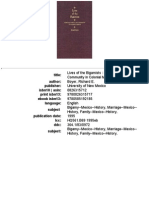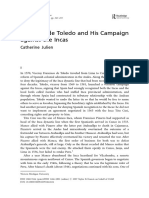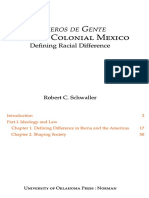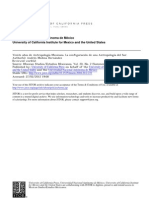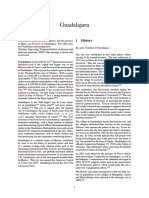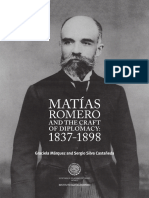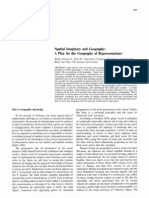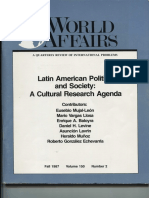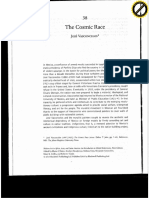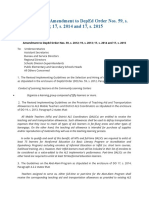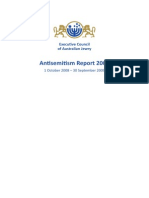Brading - Catholicism and Enlightened Despotism in Bourbon Mexico
Brading - Catholicism and Enlightened Despotism in Bourbon Mexico
Uploaded by
EquinoprietoCopyright:
Available Formats
Brading - Catholicism and Enlightened Despotism in Bourbon Mexico
Brading - Catholicism and Enlightened Despotism in Bourbon Mexico
Uploaded by
EquinoprietoOriginal Title
Copyright
Available Formats
Share this document
Did you find this document useful?
Is this content inappropriate?
Copyright:
Available Formats
Brading - Catholicism and Enlightened Despotism in Bourbon Mexico
Brading - Catholicism and Enlightened Despotism in Bourbon Mexico
Uploaded by
EquinoprietoCopyright:
Available Formats
Tridentine Catholicism and Enlightened Despotism in Bourbon Mexico Author(s): D. A.
Brading Reviewed work(s): Source: Journal of Latin American Studies, Vol. 15, No. 1 (May, 1983), pp. 1-22 Published by: Cambridge University Press Stable URL: http://www.jstor.org/stable/155921 . Accessed: 02/08/2012 18:52
Your use of the JSTOR archive indicates your acceptance of the Terms & Conditions of Use, available at . http://www.jstor.org/page/info/about/policies/terms.jsp
.
JSTOR is a not-for-profit service that helps scholars, researchers, and students discover, use, and build upon a wide range of content in a trusted digital archive. We use information technology and tools to increase productivity and facilitate new forms of scholarship. For more information about JSTOR, please contact support@jstor.org.
Cambridge University Press is collaborating with JSTOR to digitize, preserve and extend access to Journal of Latin American Studies.
http://www.jstor.org
J. Lat. Amer.Stud. 15,
1-22,
Printed in Great Britain
Tridentine Catholicism and Enlightened Despotism in Bourbon Mexico*
by D. A. BRADING
I In I799 Dr Juan Jose de Gamboa, an influential canon of the cathedral chapter in Mexico City, presented a lengthy petition on behalf of the Marquesa of Selva Nevada seeking permission to found a Carmelite convent in Queretaro, a city of some 30,000 inhabitants. Whereas the capital possessed twenty wealthy convents with over nine hundred professed nuns, Queretaro only had two established houses, the Santa Clara and the Capuchines. Marvelling that, whereas in France the Revolution had destroyed convents, in Mexico the Church was still able to found new houses, the crown attorney advised granting the necessary licence.1 A handsome edifice was subsequently designed and constructed by Manuel Tolsa, the chief proponent of the neo-classic style in New Spain, and in i803 the Archbishop accompanied the founding sisters on their journey from Mexico to Queretaro.2 Such an apparent contrast to the state of affairs in Europe should not blind us to the challenges which confronted the Mexican Church in the late eighteenth century. In the same year of 1799, Manuel Abad y Queipo, writing on behalf of the Bishop and chapter of Michoacan, roundly warned the Crown that any further diminution of clerical privilege might lead to insurrection.3 Echoing Montesquieu, he insisted that to undermine the
* Research for this article was supported by grants from the British Academy and Cambridge University Travel Fund. 1Mexico, Archivo General de la Naci6n (hereafter cited as AGN), Historia 77-I, 7 January 1800. 2 Josefina Muriel and Alicia neocl/sicas: La Marquesade Selva Nevada, Grobet, Fundaciones sus conventosysus arquitectos(Mexico, I969), pp. 35-48. 3 This memorial is reprinted in Jos6 Maria Luis Mora, Obras sueltas (Mexico, I963), pp. I75-213.
LAS I5
D. A. Brading
authority of the Church was to threaten the power of the Crown; and he pointed to the example of France to confirm his argument. In recent years the Mexican clergy had seen their immunity from royal courts broken, their control over the tithe disputed, and the authority of their courts constantly challenged by the audiencia, the high court of justice. Yet the Church still exercised a formidable influence over the population, an influence hitherto wielded in support of the Crown. Despite this pointed warning, in 1804 the Crown decreed the desamortisation of all ecclesiastical property, making the treasury henceforth responsible for the payment of interest on all capital raised by this measure. Since most church property in New Spain consisted of chantry and endowment funds lent out on mortgage to haciendas and town houses, this decree entailed a savage capital levy on the landlord class. Despite a flurry of protests from all the chief institutions of the colony, both civil and clerical, desamortisation was enforced by a corrupt viceroy, anxious to curry favour in Madrid, where the monarchy was stumbling close to bankruptcy.4 This measure, which alienated both the clergy and propertied class, who saw the patiently accumulated capital of centuries disappearing into the maws of a spendthrift treasury, was the last great act in an entire programme of assault on the Church, all designed to curtail its autonomy and appropriate its income. The Bourbon attack on ecclesiastical privilege was all the more shocking since it followed so close upon a period when the Mexican Church, under the leadership of Juan Antonio de Vizarron y Eguiarreta, Archbishop of
Mexico, 1730-47, and Viceroy of New Spain, 7 34-40, reached its apogee.
For it was undoubtedly owing to his influence that the City of Mexico, beset in 1736-7 by a devastating plague which carried off thousands of its inhabitants, acclaimed Our Lady of Guadalupe as its Patron. This proved such a popular measure that in 1747 the bishops and chapters of all the Mexican sees united to proclaim the Virgin of Tepeyac as universal patron of New Spain.5 This solemn act, which was soon ratified by the Papacy, expressed the culmination of a century-long campaign by the Creole clergy to encourage and preach veneration for this image. For it was only in I648 that Miguel Sanchez published the first circumstancial account of the miraculous apparition of the Virgin Mary in 531 to the
4 B. R. Hamnett, 'The Appropriation of Mexican Church Wealth by the Spanish Bourbon Government - The "Consolidaci6n de Vales Reales" I805-1809', Journal of Latin American Studies, vol. i, no. 2 (i969), pp. 85-113. 5 For these dramatic events see Cayetano de Cabrera y Quintero, EscudodeArmas de Mexico (Mexico, 1746; facsimile edition, 198 ), passim.
TridentineCatholicismand EnlightenedDespotism in BourbonMexico
Indian Juan Diego at Tepeyac and the equally miraculous imprinting of her image on his cape before Archbishop Zumarraga.6 Until then, the shrine at Tepeyac, built on a small peak outside Mexico City once dedicated to the Aztec goddess Tonanztin, had only attracted a local veneration, and, indeed, had been sharply criticised by Franciscan missionaries as a mask for the idolatry of Indian pilgrims. But, with the publication of Sanchez' work, Creole canons and university professors vied to exalt and propagate the cult of the Guadalupe image. In the I66os the pilgrim highway connecting the sanctuary to the capital was lined with small chapels or stations devoted to the mysteries of the rosary, and in 1695 work began on a magnificent new church. Endowment bequests mounted and in 75 I a college of canons was established to officiate at the sanctuary, the only body of this type in New Spain outside the cathedral chapters. The significance of the cult was threefold. The narrative of the apparition and the patronage conferred by the preservation of the imprinted image was interpreted by the Creole elite within the clergy as providing the Mexican Church with a heavenly foundation quite distinct from and superior to the spiritual conquest so exultantly celebrated by Franciscan missionaries from the Peninsula. It was owing to the intercession of the Virgin Mary that paganism was so rapidly eradicated from New Spain. Far from constituting a missionary extension of Europe, the Mexican Church took its start from the apparition at Tepeyac. At the same time, veneration for an image, where the Virgin Mary is depicted as an Indian or mestiza, united the Creole clergy and Indian masses in a common devotion. That the appointment of canons at the sanctuary was made conditional upon knowledge of Indian languages emphasises the popular nature of the cult. Indeed, the contemporary historian Mariano Veytia commented that each week Indian pilgrims appeared in the courtyard before the church to dance and sing hymns in their own tongue.7 Finally, the cult served to exalt the primacy of Mexico City and its Archbishop, and to unite the entire country under a common patron. In all the cathedral cities and provincial capitals of New Spain, chapels and altars were raised in honour of the Guadalupe, and in many places a sanctuary was built on the outskirts of the town connected by a pilgrim highway, in direct emulation of the relation between Mexico and Tepeyac. Here, then, we encounter both a foundation myth and a popular cult, which aroused a
6 Jacques Lafaye, Quet/alcoatland Guadalupe (Chicago, 1976) pp. 21 I-301; D. A. Brading, Los origenesdel nacionalismo mexicano (znd ed., Mexico, I980), pp. 26-9.
7
Mariano Fernandez de Echeverrfa y Veitia, Baluartesde Mexico (Mexico, edition, I967), pp, 60-2.
I 820;
facsimile
D. A. Brading
devotion which was both patriotic and religious, the very symbol of a Church that was Creole and Indian. In the same decades that veneration for the Guadalupe mounted to its climax, religious architecture entered an exuberant phase of construction dominated by the style generally called Churrigueresque. Once more the cathedral in Mexico City played a central role, calling in two Spanish architects to design the altar of the kings and the new Sagrario.The result was to introduce into New Spain the latest developments of the Spanish baroque. Thereafter, in the sixty years I730-90, the altars and facades of Mexican churches, hitherto divided into rectangular panels, their decoration and pillars all dominated by a horizontal emphasis, seemed to dance, as the traditional orders of the Renaissance were dissolved and replaced by estipetes, niched pilastres and elaborate mouldings, the sculptural detail entirely subordinated to the upward movement of the entire frame. The Santa Prisca at Taxco, the Valenciana near Guanajuato, the altars of the Santa Clara at Queretaro: all offer examples of religious architecture for which the only parallels in Europe are to be found in Andalusia and Austria.8 To judge from chronicles published at the time, both the intellectual elite and the masses joined in acclamation of the new marvels which aroused their delight and devotion, a phase which was brought to an abrupt halt by the promulgation of the neo-classic style by the official Academy of San Carlos. If central Mexico experienced a remarkable and original cycle of religious and aesthetic activity in the first decades of the eighteenth century, so also the vast territories of the northern frontier offered a theatre for renewed missionary endeavour. The foundation in 1683 of a Franciscan missionary college at Queretaro, which recruited its members from provinces in both Spain and Mexico, proved so successful that other institutes were established in Zacatecas, Mexico City and Pachuca. Similarly, the Jesuits moved across from their missions in Sonora to open new stations in Lower California. In I746 a chronicle of the Franciscan missionary colleges was published by Felix Isidro de Espinosa, a native of Queretaro, who had participated in the first entrance of Texas.9 The picture he painted was highly traditional. Once more, heroic friars, their flesh torn by self-discipline, their nights given up to prayer, victoriously
8 George Kubler and Martin Soria, Art and Architecture in Spain and Portugal and their American Dominions i0oo--i8oo (Penguin Books, London, 1959), pp. 69-8I. 9 Isidro Felix de Espinosa, Cronica apostolicay serdphicade todos los colegiosde propaganda fide de esta Nueva Espa#a (Mexico, I746; znd ed., with notes by Lino G. Canedo, Washington, 954), passim.
TridentineCatholicismand EnlightenedDespotism in BourbonMexico
combated the assaults of the Devil and converted hundreds of docile Indians, who, as always, soon fell victim to the onslaught of epidemic disease. Here, when in Europe the Enlightenment was about to gain momentum, this Creole chronicler relived and repeated the experience of his sixteenth-century predecessors. The century I648-I747, which witnessed the flowering of the cult of the Guadalupe, was a period of debility for the Spanish monarchy, a time when the vast American Empire was least subject to interference from Europe. Isolated by distance and by censorship, the intellectual elite of Mexico, virtually all of whom were priests, still fanned the last embers of scholasticism and encouraged popular devotions. Thus, if in Europe the i68os formed an intellectual watershed, when the refurbished Thomism of Suarez and the cosmological system of Kircher were finally undermined by the new science, philosophy and history of Newton, Descartes and Bayle, in the hispanic world Tridentine Catholicism continued to generate new forms of devotion and architecture well into the eighteenth century.0l The shock of change was to prove all the more painful since the evolution of religious belief and sentiment in Mexico obviously moved at a pace which was more slow and variegated than in Europe. II With the defeat of the Catholic monarchies of Europe in the Seven Years War (i 756-63), it became clear to their ministers that it was necessary to reform the Church in order to release resources for productive enterprise. In particular, the enlightened bureaucrats whom Charles III promoted to high office sought to exploit Spain's vast American Empire both as a market for the Peninsula's manufactures and as a source of revenue.11 Both 'utilitarian and dirigiste' in their political philosophy, these ministers found little value in the religious orders, asceticism, elaborate liturgy, and popular devotion which had been encouraged by Tridentine Catholicism. Instead, they promoted clerics of a Jansenizing bent, recruited from a broad middle party in the Church, who favoured good works and simple piety in place of Baroque rhetoric and mysticism. The study of the Church Fathers and Scripture was preferred to scholasticism, and the role of
10
For these trends, see R. J. W. Evans, The Making of the HabsburgMonarchjy IFo-i7oo (Oxford, 1979), pp. 432-46. 11 Jean Sarrailh, L'Espagne eclaireede la secondmoitie du XVIIIe siecle (Paris, 1954) p. I84; D. A. Brading, Miners and Merchantsin BourbonMexico I76}-I8Io (Cambridge, 1973), pp. 25-30.
D. A. Brading
Church Councils and national hierarchies emphasised against canon law theories of Papal absolutism.12 At the same time, this party re-affirmed the Tridentine doctrine of episcopal authority and the fundamental role of the parochial clergy, as opposed to any medieval exaltation of the religious life. In New Spain the administrative visitation of Jose de Galvez (I765-71) was matched in the ecclesiastical sphere by the appointment of Francisco de Lorenzana as Archbishop of Mexico and Fabian Fuero as Bishop of Puebla. It was these prelates who summoned the Fourth Mexican Provincial Council in i771 with the purpose of promulgating a general reform of the colonial Church.13 But their deliberations were overshadowed by the expulsion of the Jesuits in 1767 and the impending dissolution of the Society in 1773, a measure in which the Council fully concurred. The Jesuits had grown steadily in wealth, numbers and influence since their arrival in 5 70, and the closure of the colleges which they maintained in all the leading cities was never to be repaired. Hitherto, the hierarchy had relied on these colleges to educate aspirant clergy, so that it was now necessary to establish Tridentine seminaries, endowed with scholarships for poor students, in order to procure an adequate supply of secular priests. As regards the laity, the vacuum in higher education was not to be filled until the I86os when a positivist curriculum was introduced. If the abrupt expulsion of the Jesuits expressed the ruthless determination of Charles III and his ministers to brook no opposition to their programme of Church reform, it should not be forgotten that the first step in this general assault was taken in 1749 when the Crown ordered the secularisation of all parishes still administered by the religious orders. This decree derived from complaints received from the viceroys of Peru and New Spain about the excessive numbers, wealth and disorders of religious communities in the New World. Acting on the advice of his father confessor, the Jesuit Manuel de Rabago, Ferdinand VI by-passed the normal administrative machinery of the Council of the Indies, and convoked a special committee of 'theologians and jurists', on which sat both the Archbishops-elect of Lima and Mexico, to consider what should be done.14 That this committee fixed upon secularisation as the most
Joel Saugnieux, Le Jansenisme espagnol du XVIIIe siecle, ses composanteset ses sources Revolution in Spain (Princeton, (Oviedo, I975); Richard Herr, The Eighteenth-Century I958), pp. 400-27; Owen Chadwick, The Popes and the European Revolution (Oxford, 1981), pp. 392-439. 13 N. M. Farriss, Crownand (London, 1968), pp. 26-3 8. Clergyin ColonialMexico i7,r-182i 14 Archivo General de Indias (hereafter cited as AGI), Mexico 27I6. The president of this junta was Jose de Carbajal y Lancaster.
12
TridentineCatholicismand EnlightenedDespotism in BourbonMexico
appropriate remedy should come as no surprise since this was an issue which had divided the colonial Church since the I570s. The heroic task of evangelising the Indians had been assumed by the mendicant orders of Franciscans, Dominicans and Augustinians, who in the first decades after the Conquest dominated the new church. From the 1570s onwards bishops attempted to wrest parishes from the mendicants and install secular clergy, a campaign which reached a stormy climax in the I64os when the intransigent bishop of Puebla, Juan de Palafox, abruptly ejected all Franciscans from their doctrinasin his diocese, establishing a Tridentine seminary for the instruction of his parochial clergy. But his example was not followed in other dioceses and even in Puebla friars were allowed to retain their small country convents. By the I740s at least two-fifths, if not more, of parishes in the central dioceses of Mexico and Michoacan were still administered by religious scattered across the countryside in small houses where complete observance of their Rule was virtually impossible. Indeed, small provinces such as the Dominicans of Puebla and Oaxaca, and the Franciscans of Guadalajara only possessed one large central convent and located the majority of their members in the Indian parishes. Even a province so well endowed as the Augustinians of Michoacan, with several large urban priories, kept two-thirds of its priests in doctrinas. Moreover, the preponderance of religious in the Indian ministry was probably greater than a mere enumeration of parishes might suggest since the districts under their control were so large that after secularisation they were divided. Through secularisation the number of parishes rose from 188 to 241 in the archdiocese of Mexico.15 Since implementation of the 1749 decree, limited at first to Mexico and Lima, met with so little resistance, either from the populace or from the religious, in I753 the policy was extended to all other dioceses. On inspection it was found that many parishes lacked a canonically appointed curaor that the incumbent was absent serving as prior in an urban convent. But the high-handed fashion in which both parishes and convents were seized soon gave rise to bitter protests from the mendicants in New Spain. The Generals of the three Orders united to complain to the Crown that friars had been expelled from their cells, allowed to take only their personal belongings and at times forced to find their way on foot back to the capital. 'They were handled as if they were law-breakers, their honour insulted, and treated here in America with a hostility and rigour that was not shown
15
Jose Antonio de Villasenior y Sanchez, TeatroAmericano(2 vols., Mexico, 1746), I, 26-30; Fernando Navarro y Noriega, Catdlogode los curatosymisiones la Nueva Espaga (Mexico, de 18 2 and 1943), passim.
D. A. Brading
to the Moors and Jews when they were expelled from the Peninsula.'16 It was not so much the loss of parishes that so affronted the Generals as the seizure of priories built in the heroic age of missionary endeavour, houses such as Acolman and Tzintzuntzan, which enshrined the collective glory of Spiritual Conquest. Moreover, since the incoming priest often had no use for such extensive premises, the convent buildings were at times rented to serve as stables, as popular tenements, or for textile obrajes.The Generals predicted that secularisation would bring disaster for both religious and Indians. On the one hand the Indians would sink back into idolatry since, whereas the mendicants had always made a special point of teaching and confessing them in their own languages, the secular clergy rarely knew anything more than Castilian. Moreover, whereas eight or ten friars administered an extensive parish at a cost of 3oo pesos each, a secular priest required at least Iooo pesos and hence would employ one or two assistants. As for the mendicants, they would now be forced back into the great city priories and become a burden on the urban population. This bitter denunciation of royal policy, although supported by the Creole council of Mexico City, received short-shrift from the Archbishop, Manuel Rubio y Salinas and Viceroy the Count of Revillagigedo, both of whom counselled the Crown to continue the measure. Apprehensive of its impact on the religious, however, the Father-Confessor consulted with the Minister of the Indies, Julian de Arriaga (whose confessions he also heard), and in 1757 modified the severity of secularisation by permitting canonically appointed encumbents to remain in their parishes until their death or resignation. Each Province was to be allowed to retain two wealthy parishes in perpetuity. Thirdly, all convents which housed eight or more religious were to be returned or retained, and new churches built for the secularised parish.17 Moreover, where property belonging to convents had been embargoed, this was also returned. With the modifications of 75 7 the Provinces were given respite from immediate loss of all their parishes so that the process of reorganisation was gradual. Moreover, in the peripheral dioceses, which lacked a numerous secular clergy, further concessions were extended. In 1766 the Bishop of Yucatan thanked the Crown for allowing the Franciscans to keep the twenty parishes they still administered in his see. Similarly, in Oaxaca, the Dominicans eventually retained twelve out of the 2 i doctrinas they had once possessed, with the Province of Puebla keeping another two they had managed since the seventeenth century. In Jalisco the Franciscans - a small
16
AGI, Mexico
2712.
See also the protest of Mexico City Council,
27
July 1753.
17 AGI, Mexico 2716, real cedula 23 June I757.
TridentineCatholicismand EnlightenedDespotism in BourbonMexico province of I 64 religious - were granted permission in 1775 to keep twelve
parishes for another twenty years so as to enable them to construct new priories; hence it was not until 1798 that they were finally subject to secularisation.18 In both Mexico and Michoacan, however, the policy was implemented in all its rigour. The impact of secularisation on the Indians admits no easy assessment. Despite the assertions of Archbishop Rubio that his diocese possessed an abundance of candidates with knowledge of Indian languages, several parishes were in fact given to priests who could only preach in Castilian. Indeed, the very Archbishop protested privately to the Crown that Viceroy the Marquis of Amarillas and his wife both attempted to secure benefices for their chaplains, young men from the Peninsula, without any more qualification than their social connexion. Indeed, the Franciscan Provincial noted sourly that Rubio himself was guilty of much the same offence.19 The logical corollary of this problem was to establish a chair of Mexican language in the diocesan seminary for the instruction of future ordinands, and, on the other hand, to teach the Indians Castilian. Rubio remarked that he had contemplated the prohibition of the use of Indian languages in all adminstration of the sacraments, but instead decided first to establish schools in every parish, financed out of community funds. His successor Lorenzana continued this policy of discrimination against the use of native languages.20 The extraordinary arrogance which animated these 'enlightened' prelates can be best observed in a pastoral issued in I803 by the new Bishop of Oaxaca, Antonio Bergosa y Jordan. He positively reproached his flock for 'maintaining your rough, unknown tongues', arguing that with eighteen different languages Oaxaca resembled a Tower of Babel. He observed that 'one of the chief tricks of the Devil has always been to prevent the use of our Castilian language' and admonished his Indian subjects to abandon the use of their 'barbarian' tongues, which had prevented their advance in Christian knowledge and civility. Here we encounter an astonishing contrast to the practice of the missionaries of the sixteenth century and a precursor of Liberal policies of the nineteenth.21 In the short term, however, the problem was often solved by the increasing recruitment of an Indian clergy often financed by scholarships in the new
18
For Yucatan, see AGI, Mexico 3173, Bishop's letter, 3 October 1766; for the Dominicans, AGI, Mexico 1308, real cedula, 4 February I78 I; for Franciscans of Jalisco, AGN, Clero 4-I, real cedula I5 July 1797. 19 AGI, Mexico 2716, Archbishop Rubio to Arriaga, i March I759. 20 AGI, Mexico 2714, Archbishop Rubio to Arriaga, 21 April 1756. 21 AGI, Mexico 265I, Printed pastoral, 29 March I803.
io
D. A. Brading
diocesan seminaries, who then served as assistants to the parish priests or who were given isolated country benefices. The impact of secularisation on the religious is more easy to chart. Cut off from their rural ministry, they were forced back to their city priories, or sent to the northern missions. In 1763 the Crown demanded that the intake of novices should be reduced and in 177I despatched Visitors to inspect each Order to frame a scheme of maximum recruitment for every convent and Province in New Spain. Some measure of these changes can be observed from the experience of the central Franciscan Province of the Holy Gospel, which covered the dioceses of Mexico and Puebla. Prior to secularisation, the Province held 35 parishes and had 88 convents to house a total membership of 840, divided between 700 professed religious and 140 lay-brothers. Left with only the two parishes of Texcoco and Toluca, they were obliged to abandon most of their small country houses, so that by 1794 the Province only counted sixteen priories and another 4 houses of recollection. The intake of novices was cut back from about
00oo-20
to 60 for comparable six-year periods immediately before and after
secularisation. Overall numbers fell to 630 professed religious in I765, together with 97 lay-brothers.22 Thereafter, membership declined still further since, if as a result of secularisation the great priory in Mexico City had over 150 residents in the i76os, by 1792 this figure had fallen to 9I priests and 25 lay-brothers. Yet more ominous for the future, the census of that year only counted eight novices.23 Much the same trend was to be found in the Augustinians of Michoacan, where the loss of 32 parishes left the Province with eleven convents. Moreover, in order to reduce numbers from 274 in 1776 to the much lower figure of 170 demanded by the Visitor, it was necessary to close the novitiate for ten years until natural wastage and the fevers of the famine years 1784-6 carried off sufficient men. By 800othe Province had 177 professed religious, 16 lay-brothers and io novices.24 The Crown thus largely succeeded in its programme. Parishes were secularised and small country priories suppressed. The third aim, of encouraging the established provinces of central Mexico to enter the northern mission field, was less effective. The Franciscan Province of Holy Gospel maintained a circuit of missions in both New Mexico and in
22
23
24
Bibliotecta Nacional, Archivo Franciscano, Caja 127, documentos I647-5 ; AGI, Mexico 3173, real cedula I4 October 1763 on reduction of novitiate. This census is reprinted in Alexander von Humboldt, Ensayopolitico sobreel reino de la Nueva Espana (Mexico, ed. J. A. Ortega y Medina, i966), p. 573. Nicolas P. Navarrete, Historia de la Provincia Agustiniana de San Nicolds de Tolentonode
Michoacdn (2 vols., Mexico, I978), I, 552-3, 56o-6, 594-6, 719; II, 88, 158.
TridentineCatholicismand EnlightenedDespotism in BourbonMexico
Tampico, but only 55 of its members served in these territories. Other provinces had even less engagement with mission activity, so that the burden still fell upon the Franciscan Colleges of Propaganda Fide which mainly recruited their staff directly from the Peninsula. Whether the loss of the rural ministry and the enforced retreat into the city priories was a cause of decline in fervour is difficult to say. But, whatever the case, all observers agreed that by the end of the eighteenth century the religious orders in New Spain had entered a phase of crisis. It was not simply that the old battle over the alternativabetween European and Creole members once more became a matter of bitter controversy in some provinces. Rather, concern centred on the growing number of individual secularisation, by which religious obtained from Rome liberation from their vows.
Both in 1797 and I805 the Crown issued decrees warning the hierarchy
against accepting any individual secularisation licences which had not been cleared in Madrid. These decrees commented on 'the excessive number of secularised religious', and complained of'the harm which is experienced as the convents of those dominions are being depopulated... '.25At much the same time the Provincial of the Carmelite Province, commenting on the exit of so many of his Friars, exclaimed that 'if Our Lady does not deign to find a remedy, then within a few years this Holy Province of St Albert will see its end .26 Certainly, the records of the Council of the Indies for these years are full of applications from religious of all Orders for secularisation at a time when the flow of new novices had apparently dried to a small trickle. The decline in religious fervour, when combined with Crown policy, thus created a crisis which threatened the very survival of the mendicant orders in New Spain. III The suspicion of all forms of popular organisation displayed by colonial authorities is nowhere better illustrated than in their attitude to religious confraternities, bodies which in some cases could trace their foundation to the sixteenth century. Both their expenditure and their liturgical life proved a source of disquiet. In New Spain an enquiry into these bodies started in i775 when the Royal Accountant of Community Funds
25 Archivo Casa Morelos (hereafter cited as ACM) Cedulas reales y decretos, I, 12 August I805; AGI, Indifferente general 73 has these comments of the Bishop of Havana: 'there is not a convent of regular clergy in this city from which religious of all classes have not petitioned me for secularisation'. 28 June I796. 26 ACM, XIX, N.D. 34, I 3 March I804.
i2
D. A. Brading
discovered that many Indian villages lacked any collective fund because their lands, capital and cattle had all been absorbed by confraternities whose income was devoted to 'Church ceremonies, dinners, fireworks and other useless and harmful things'. Not only did the Indians themselves suffer from the attendant expenditure, but at times royal tributes could not be collected.27 On learning of this sorry state of affairs,the Crown attorney, Juan Antonio de Areche, whose Visitation in Peru was later to provoke the Tupac Amaru rebellion, at once called for the suppression of all these confraternities and the return of their property to the villages. Similarly, the Bishop of Oaxaca suggested that each village should be allowed only one brotherhood, in which were to be enrolled all its adult members, with a small charge made for the upkeep of the local church and its liturgy. These suggestions were not implemented, and intervention was limited to declarations that confraternities and their goods were temporal rather than spiritual in nature and hence not in any way exempt from royal jurisdiction and taxation. But then, in I79I, decrees were issued demanding that a royal official must be present at all confraternity meetings. Intendants were instructed to treat all unauthorised meetings as 'clandestine and illegitimate' and ordered to investigate the foundation licenses of all confraternities in their province. The result was to show that very few of these societies had obtained royal license or had proper constitutions. In 1794 the Archbishop Alonso Nufiez de Haro informed the Viceroy that he had enumerated no less than 951 confraternities, brotherhoods and congregations in his diocese, of which he had already abolished 5oo. However, he suggested caution where Indians were concerned since they were 'very tenacious in maintaining their customs and devotions' and might well riot if their brotherhoods were suppressed. He stated that provided the parish priest or a royal magistrate was present at their meetings no harm would come from their continued existence.28 For the rest, he suggested that the Viceroy be empowered to approve new foundations and existing constitutions since it was far too costly for most associations to solicit the requisite papers in Madrid. In I796, however, the Crown ordered that all existing confraternities had to obtain a licence from the Council of the Indies, submitting copies of their constitutions for approval. Thus, under threat of immediate extinction, Mexican confraternities had to revise their ordinances, often in force since the seventeenth century, and, at considerable expense, submit to bureaucratic review. Even then approval was not always forthcoming.
27
28
AGN, Obispos i8, Contadorde propios y arbitrios;Bishop of Oaxaca, 5 May 1778. Ibid.,Archbishop Haro to Viceroy Revillagigedo, 24 May I794.
TridentineCatholicismand EnlightenedDespotism in BourbonMexico
13
When in 1796 four confraternities of Toluca, dedicated respectively to the Holy Sacrament, the Holy Cross, St Febronia, and the Rosary and Holy Souls, applied to the Council of the Indies, the Fiscal roundly denounced: the prejudice and disorder produced by the countless number of guildconfraternities and other bodies which through whim, seduction or vanity have been establishedand are increasingevery day in the churchesof both the regular and secular clergy, in chapels and convents, throughout the Dominions of the Indies... all redoundingto publicharmby reasonof the weekly contributions,the excessive costs of the mayordomias,through which countless families of poor subjects are ruined every year. His suggestion that only two confraternities, dedicated to the Divine Sacrament and Holy Souls, should be allowed and the rest prohibited, was accepted by the Council of the Indies.29 Whether their subsequent decree was ever put into effect remains uncertain. The difficulties which lay in wait for confraternities seeking approval can be further observed in a case from Calimaya in Tenango de Valle, where since 1785 parishioners had petitioned for permission to establish a confraternity dedicated to St Joseph and Holy Souls. It was in I802 that the same Fiscal of the Council of the Indies reviewed their proposed ordinances and strongly objected to the provision of 25 pesos for the funeral of their members, arguing that brothers should not be given a more elaborate ceremony than what was appropriate to their social class. Surplus funds should be spent 'in succour of poor prisoners or the sick or other useful things for their neighbourhood'. More generally, he suggested that all other confraternities in the parish church should be abolished, and asked that the Viceroy be exhorted 'to render uniform and organise these useful establishments which sustain the liturgy, benefit the souls of the departed and remedy the necessities of the ill and invalid'. Returning to his previous proposal, he advocated the amalgamation of these societies, retaining only two dedicated to the Divine Sacrament and Holy Souls, with the aim of supporting the liturgy and paying funeral costs.30 In these proposals, we encounter evidence of the reiterated ambition of the Bourbon bureaucracy to regulate all aspects of social life in Mexico, ambitions, we may suspect, more easily realised on paper than in reality. But what was the purpose of this multitude of confraternities? Were they as important or as pernicious as the Fiscal claimed ? Before any answer to this question can be offered, it is necessary to distinguish between the various types of society all listed under the same heading. In this respect,
29 AGI, Mexico 265x, Fiscal i6 October I796. 30 Ibid., Fiscal 3 September I802.
14
D. A. Brading
the I794 report of Archbishop Haro is helpful since he made a broad distinctions between the mayordomi'as, confraternities and brotherhoods of the Indians, few of which possessed any date of erection or formal constitution, and the confraternities of the hispanic community (including mulattoes under this head) all of which had some kind of ecclesiastical, if not royal, sanction and license. These associations he divided into three categories: retribucion temporal,by which he meant societies which charged a fee and in return paid the funeral expenses of all members; those which simply supported liturgical functions; and finally a smaller group, called spiritual,which obtained special indulgences in return for regular prayers.31 A further distinction could be drawn between confraternities which were based on a particular profession or guild and those which recruited at large from the population. What is important to note is that virtually all these organisations were self-governing, met regularly, and, therefore, were an important form of lay action. At the same time, all confraternities raised money to meet the cost of liturgical functions, thus providing an important source of revenue for the parochial clergy. To judge from a detailed report from Michoacan in I799, the Indian confraternities in that area did not differ greatly from the mayordom'as described so often in modern anthropological surveys.32 Each barrio or ward of a village appointed a mayordomowho was responsible for organising the procession, mass and sermon on the feast day of the patron saint, with the obligation of providing a light repast for the participants. were appointed to organise celebrations for Similarly, other mayordomos such important feast days as Corpus Christi, the Finding of the Holy Cross, and the patron saint of the entire village. In these fiestas, however, he was assisted by Captains who organised the famous dance of Moors and Christians and the battle of the Archangel St Michael and Lucifer. Together with Holy Week, these were the chief feasts of the Indian year and were celebrated with great pomp and expense. Finally, in most villages in Michoacan there was a hospital dating back to the sixteenth century or which was administered either directly by a prioste and mayordomo by means of a confraternity invariably dedicated to the Purisima Concepcion. In the Tarascan village of Cutcio this hospital confraternity possessed an endowment of 328 cattle and 20 horses which grazed on communal lands and a plot of land sufficient to sow about 2 fanegas of maize and a quarter of cotton. The income from this endowment was apparently sufficient to
31
32
AGN, Obispos I8, Archbishop Haro 4 May 1794.
AGN, Historia 73-I8, has a village-by-villagedescription;severalare printed in Jose Bravo Ugarte (ed.), Inspeccidn ocular Michoacdn en (Mexico, I960).
TridentineCatholicismand EnlightenedDespotism in BourbonMexico
I5
meet the cost of sung mass every Saturday, a funeral mass for every villager when he died, candles for the weekly rosary procession, and solemn mass and sermon on the five principal feasts of the Virgin Mary. In other villages, such as San Francisco Istlan, however, it was the prioste who had to meet the expense of these occasions, 'feeding those who act as Apostles in Holy Week and inviting the other natives on Christmas Eve for atole, the Tuesday of Carnival with tamalesand the day on which the villages offices are taken up, that of Holy Thursday and of the Purisima Concepcion with a small meal worth about 22 pesos'. In short, Indian confraternities were distinguished by their barrioaffiliation, their connexion with the hospital, by the elaborate processions and dances which accompanied their chief feasts, and by the provision of a meal for their participants. As yet, far less is known about the confraternities of the hispanic sector of the Mexican population since many, if not most, were suppressed or died a natural death in the nineteenth century. If some of the older bodies existed to celebrate great feasts, others were the religious side of such guilds as coachmen, tailors and shoemakers. Similarly, the two great parties of the merchant guild, the Consulado, each had their own confraternities, Christ of Burgos for the Montafieses and Our Lady of Aranzazu for the Basques.33 Great disparities consequently existed in their resources, with the prestigious arch-confraternity of the Rosary in Mexico endowed with property worth over half a million pesos and other societies with one or two houses yielding rents of 300 pesos a year.34 In function, the chief distinction lay between burial societies and those associations which existed simply to support liturgical occasions. To take the case of a small burial society - the confraternity of San Roque attached to the Franciscan priory at Valladolid (Morelia) - each brother had to pay an entrance fee of two reales and a fee of half a real every week. In return the confraternity gave I2 pesos or a Franciscan shroud for the funeral of every brother, together with a sung mass attended by all members of the association carrying candles. The confraternity also held a monthly mass and procession in the cloister, and carried its banner through the streets in Holy Week, and, of course, celebrated its patron's feast with especial solemnity. Where the funds did not cover all the and expenses of these functions, it was up to the mayordomo the governing board of twelve deputies to reach into their pockets.35 This was a small
33
34 35
Brading, Miners and Merchants,pp. 107-109. AGN, Cofradfas 6, has a list of Mexico City confraternities and their endowments. ACM, xvIII 359, constitution approved 4 May 1767 at petition of mayordomo, Jose Sim6n Gonzalez, an Indian cacique.
I6
D. A. Brading
association composed of urban Indians and poor artisans, but its constitution was much the same as other societies of this type: all made provision for funeral costs, celebrated a monthly mass, and entered the processions of Holy Week. By contrast, the confraternities of the Most Holy or Divine Sacrament, at times dignified with the title of Archconfraternities, had as their object 'the most religious, sumptuous and magnificent cult of Our Lord Jesus Christ in the most august sacrament of the Eucharist'. Such societies recruited members from the leading families in each city who bore much of the expense of the liturgical functions associated with Holy Week and Corpus Christi. In Queretaro, the confraternity, which numbered about 200, was open to members of both sexes, who paid an entrance fee of 2 reales and a weekly contribution of half a real.36 In San Luis Potosi the confraternity had an income of Io80 pesos a year from houses it had acquired since its foundation in 594. It engaged in a variety of charitable work as well as supporting the local church. By I792 it maintained its own chapel in the parish church where each year 22 sung masses were celebrated in memory of benefactors.37 In short, such associations supported and organised an entire range of liturgical functions for both the parish at large and for their members, which in turn yielded an important source of revenue for the parochial clergy. Granted their importance, it comes as no surprise that the colonial authorities should have insisted that a royal official or magistrate should attend their meetings. Equally, as the royal treasury approached bankruptcy, it was only to be expected that confraternity funds should be included within the provision of the desamortisation decree of 1804 despite the prior declaration of their essentially 'temporal' nature. IV If the confraternities were generally too valuable to the clergy to allow their suppression, many of their public functions came to be viewed with disfavour both by the civil authorities and by the hierarchy. The result was an official campaign to prohibit what was deemed to be distasteful, irreverent or wasteful expenditure on the parade of images through the streets. It was that paragon of enlightened despots, Viceroy Revillagigedo (the younger), who in 1794 sharply criticised the processions of Holy Week in Mexico City where the leading confraternities carriedpasos or floats with images of their patron or of scenes of the Passion, followed by the cofrades
36
AGN, Clero I95-9, petition for recognition, 24 September 1794. 37 AGN, Clero 72-19, real cedula 24 March 179i approving constitution.
TridentineCatholicismand EnlightenedDespotism in BourbonMexico
17
dressed as penitential na.arenosor armed as Roman soldiers. He complained that the populace wasted their money in hiring costumes and arms, so that they fell into debt, neglected their families, and ended this sorry career unable to pay their tributes. The processions caused ridicule and in future, so he decreed, no further uniforms or arms should be worn. His observations include an excellent description of Holy Week in the capital, with processions starting on Monday and lasting until Saturday.38 It all sounds very similar to what can still be observed in modern Seville. Enlightened clergymen shared the prejudices of their civilian mentors. They were no longer willing to countenance the cheerful mingling of temporal and liturgical celebration so typical of Tridentine Catholicism. They sought to ban popular fiestas and carnivals. Thus, in 1804 the Bishop of Michoacan, Antonio de San Miguel, prohibited the processions and floats which were staged in several towns of the Bajio on Christmas Eve, since the crowds which attended these functions had converted 'this devout act into a scandalous spectacle'. In future only the image of the Virgin Mary could be paraded, accompanied by the faithful carrying candles. Two years later the Subdelegate of Celaya protested that this prohibition was greatly resented since Christmas Eve was a popular fiesta with people coming into the town from ten leagues about. It had been the custom to parade through the streets various pasos or images on wagons, 'dressing children of five or six as shepherds and other figures'. His plea met with temporary relief since the bishop granted a license for the procession provided that the children be properly clothed, in particular those who represented Adam and Eve, and that the function be brought to an end by 9 o'clock at night. But in 1807, after further complaints from a local cleric that the images brought religion into disrepute - he cited the dress of the Magi and the beheading of the Holy Innocents as the chief cause of levity - all further parades of this nature were summarily banned throughout the diocese.39 To meet popular demand for celebration, however, the municipal magistrate of Salvatierra hit upon an ingenious compromise whereby he authorised a 'civic paseo' with a shepherd's hut carried on a wagon accompanied by shepherds dancing without any sacred images or figures. The diocesan authorities had no choice but to approve this secular diversion, simply stipulating that the wagon and dancers set out after the procession of the rosary had entered the Church, a striking example of the separation of secular and sacred rejoicing.40
38
39 ACM, XIX, N.D. 33, prohibitions 3 December I803, 7 July I807. 40 Ibid., Salvatierra November
AGN, Historia 437, Viceroy Revillagigedo, i8 March 1794. magistrate 14 I807.
i8
D. A. Brading
Both sets of prohibitions, it will be observed, were as much based on aesthetic prejudice as on religous principle. The images and the costumes on these occasions were described as absurd or ridiculous, and, as such, irreverent. At times there entered a note of European contempt for colonial practices or of Creole disdain for Indian mentality. Thus, for example, the parish priest of San Pedro Paracho, who confessed that he did not understand Tarascan, nevertheless, denounced the Holy Week custom whereby an Indian was chosen to represent Christ, his body painted with the signs of the Passion 'the face, shoulders and body bathed in blood', who was kept prisoner from Holy Thursday until noon the following day when he was taken and tried before Pilate and Herod, with all the ceremony spoken in Tarascan. The priest commented that it was all conducted 'in accordance with the Passion but ill-sounding to my way of thinking, since I did not see anything which moved them, even in the outward sense, to devotion... when these barbarians went from house to house asking for Jesus of Nazareth'. His predecessor has wished to extinguish the practice but feared, as he did, to provoke a riot since 'they are so tenacious and bound to their customs'.41 If the ecclesiastical authorities thus feared to meddle with Indian villages, by contrast they displayed no such forbearance with urban confraternities. The growing fissure between clerical opinion and popular religion is nowhere better illustrated than in Silao, where in 1793 Bishop Antonio de San Miguel summarily banned the parade of images during Holy Week. His grounds for this decision were familiar: the processions caused excessive expense to the Indians and led to drunkenness and disorders. The images themselves were 'for the most part indecent in their construction and much more indecent in their adornment' and hence brought religion into ridicule. The populace did not want silent, pious processions, but rather occasions which would satisfy their inclination for 'uproar, puerile ostentation and pernicious meetings'.42
41
42
ACM, xviii 648, Vicente de Loredo, 31 March 1788. The entire case can be found in AGN, Historia 437. Petitions of mayordomos 3 April I797; Bishop to Viceroy, I June I798. The original Spanish is as follows: '...que la devoci6n de los fieles, principalmente de los pobres ignorantes, se va entibiando notablemente y acaso ha quedado solo en una sombra y de hay necesariamente es fuerza que se siga mayor relajaci6n de costumbres, por el mismo caso de que les faltan estas vivas representaciones o imagenes, que son las que les causan impresi6n para que formen alguin concepto o idea de los sublimes misterios de la religi6n porque su rusticidad e ignorancia, muchas veces no cede, o se da vencida a la explicaci6n de las palabras, por muy claras que sean, si a esto tambien no se les afade un objeto que se les entre por la vista o que pueda acomodarse para tocarlo con lo material de los sentidos, mejor que comprehenderlo por medio del discurso o de qualesquiera otra operaci6n o
TridentineCatholicismand EnlightenedDespotism in BourbonMexico
19
What makes this case unusual, however, was not the prohibition and prejudice of the Bishop but rather the defence offered by the mayordomos of the confraternities, who described themselves as Indian tributaries, 'ladinos' in the Castilian tongue, representing the artisan guilds of Silao. and Indians, who used They complained that the country-folk, rancheros to attend the Holy Week celebrations in Silao, no longer came to town but sought out more distant places where processions were still held. Commerce had suffered. Equally important, they argued that the faith of common people was now growing cold since it lacked the stimulus of spectacle and physical representation. In a passage which deserves to be quoted in its entirety they set out the case against the prohibitions of the Jansenizing clergy. The devotion of the faithful, especially of the poor and ignorant, is becoming lukewarmand soon will arriveat a mere shadow... for the very reason that they or lack those living representations imageswhich so createan impressionon them that they form some idea or concept of the sublime mysteriesof faith, because their rusticity and ignorance does not yield or let itself be conquered by any explanationin words, no matter how clear, unless there is not added an object which teaches them by sight or can be so adaptedas to teach them through the materialof their senses... Which is to say, that since the doors to their intellect are sealedagainstany discourse,entrancehas to come through the senses, if they are to perceive anything or form some idea of the mysteriesof religion. Of this truth all parishpriestsand confessorsare faithfulwitnesses, since no matterhow much they preach and explain to the people in the most simple words or with the clearestcatechism,they alwaysmeet with most crassignoranceof the mysteries of religion among the populace... Here, in these simple and at times ungrammatical words of these acculturated Indian artisans of the Bajio, we encounter a clear echo of missionary doctrine derived from the sixteenth century. The first mendicants in Mexico were soon persuaded that the best, if not the only way, of converting and holding the Indians to Christianity was by means of emphasis on collective liturgy rather than on individual morality. The great mysteries of the Passion and life of Christ were depicted and enacted in countless variations and ceremonies. It was a lesson that the enlightened
entendimiento:que es decir en dos palabras,que lo que no se les puede hacerpercibir porque tienen tapiadaslas puertas del discurso, se les entra por los sentidos, y asi se consigue que formen algun concepto de los misterios de la religion. De esta verdad pueden ser testigos fidedignos todos los curas y confesores, pues por mas que se mas rurales,o con el masclaroy vulgar prediquey se expliqueal pueblo, con las palabras catecismo,siemprese encuentraen la gente de la plebe una crasisimaignoranciade los misterios de la religi6n, no por falta de ensenianza doctrinade los pastores, pues es y bien notorio su celo, sino por falta de comprehensi6nde las ovejas.'
20
D. A. Brading
clergy of the late eighteenth century chose to ignore, more persuaded of the necessity of good taste and sober piety. Whereas the baroque culture of late Tridentine Catholicism had succeeded in uniting both intellectual elite and the masses in common devotion and equal aesthetic delight, by contrast its repudiation led to a growing division between educated opinion and popular religion. V In i 805 the Fiscal of the Council of the Indies received a denunciation of an elaborate annual procession which had been organised in recent years by a leading prebendary of the Cathedral chapter in Mexico City for the purpose of soliciting alms to obtain the canonization of Blessed Felipe de Jesis, a Mexican-born Franciscan martyred in Japan.43 According to the informant, the procession from the cathedral to the convent of San Francisco began with fifteen images of the martyr carried by the city guilds, with accompanying floats depicting scenes from his life, some of which were done in grotesque style, with a Devil in horns and tail dressed in the most recent dandy fashion and a Chinese torturer with a Jacobin cap. Then there followed the religious communities, the university, the cathedral chapter with its choir, and the city council with three bands and a picket of soldiers, all parading along streets lined with coaches and crowded with people. Needless to say, the royal attorney deplored such a ridiculous spectacle enacted in a capital as civilised as Mexico. He demanded that the prebendary be reprimanded, the collection of alms suspended and the procession banned. In this instance, however, the Council of the Indies decided to listen to the comments of the Viceroy and Archbishop, both of whom advised caution. For the prebendary, Jose Joaquin Ladron de Guevara, was son of the venerable Creole regent of the audiencia, and backed by the city council and university, both bastions of the Creole interest. Moreover, the parish priests of the capital warned that the cause of Felipe de Jesus enjoyed widespread support among the populace, and any attempt to ban the procession might lead to disturbances. Guevara himself declared warmly that all Americanos venerated their martyred compatriot and lived in hope of seeing their country endowed with an American saint. In the light of these reports, the diocesan authorities chose to allow the processions to continue. It was at much the same time that the newly arrived Archbishop, Francisco Javier de Lizana, warned ministers in Madrid about the dangers
43 AGI, Mexico 2693, Fiscal's comment
z2February I807.
TridentineCatholicismand EnlightenedDespotism in BourbonMexico
21
of allowing the royal courts and magistrates to undermine episcopal jurisdiction by accepting the appeals known as recursos defuerza, a device which threatened to nullify the operations of diocesan courts. At the same time he deplored the ease with which religious obtained individual secularisations, a trend which might well undermine the position of the Orders. In all this he perceived dangers for Spain since the colonial system had depended on the loyalty of the clergy, since 'he who has the curas, has the Indians'.44 These premonitory words were ignored, however, and with desamortisation all the multiple institutions of the Church suffered peremptory extortion of endowment capital built up over nearly three centuries. This assault on clerical property and privilege was all the more dangerous because, if the religious orders had entered a permanent decline, the secular clergy were on the increase. The greater number of available parishes and the opening of Tridentine seminaries endowed with scholarships had made the priesthood a more attractive career for men of some ability and few means. Indeed, the necessity of catering for Indian parishes had driven bishops to admit candidates for the special purpose of this rural ministry. For example, in 1770 the Bishop of Michoacan, Pedro Anselmo Sainchezde Tagle, proudly opened his new seminary, a grandiose building situated on the main street of Valladolid (modern Morelia) directly opposite the cathedral. Each year the college offered thirty scholarships for candidates to the priesthood, including six reserved for Indian caciques. Other students were charged a fee of 0oopesos.45 The result was an influx into the Church of men who sought a comfortable livelihood or an income to support their families. In I8I I Manuel Abad y Quiepo, by then bishop-elect of Michoacan, judged that 'the clergy have increased excessively in number', since, whereas the secular priests in his diocese numbered over I 200, there were still only I I4 parishes and 38 endowed sacristries to support them. Of the thousand or more priests left without benefice or fixed abode, he calculated that only about a half were engaged in the exercise of their ministry, serving as curates or chaplains, so that 'the other 500 remain without occupation or prospects, in a state of indigence and on the point of abandoning their orders'.46 By this time capellan/as (chantry annuities) rarely yielded an income sufficient to cover more than a bare subsistence.
44 AGI, Mexico 1892, Archbishop to Jose Antonio Caballero and Pedro Ceballos, October 1804. 45 AGI, Mexico 2622, Sanchez de Tagle, 20 February 1772. 46 Printed edict issued by Manuel Abad y Queipo to diocese, 7 March 8I .
22
D. A. Brading 3,oo0 and 5,ooo pesos, their impecunious assistants
Similarly, if the incumbents of wealthy urban parishes could expect
incomes of between
(vicarios)had to be content with 500 pesos or less. In short, in the diocese of Michoacan, a clerical proletariat had emerged with little hope of obtaining a parish or, indeed, of more than an exiguous livelihood. In 1809 the two curasof Irapuato noted that the parish, situated on the fertile plains of the Bajfo, close to the mining city of Guanajuato, housed 32 secular priests. Commenting on the modesty of their attire they attributed it to the 'infelicity and misery of most of them, since even when they have a capellaniait is not known how they support themselves. The alms from their masses are few. The poverty and lack of means for ecclesiastics in
this kingdom is constant.'47
Our evidence thus indicates little decline in popular religion in lateeighteenth-century Mexico: the Indians tenaciously retained their round of feasts and processions, and the urban confraternities appear to have attracted as much support as ever. Similarly, the female orders still obtained nuns for their convents. In short, the long-term process of secularisation and erosion of faith which had undermined the position of the Church in Europe was barely noticeable in Mexico other than at the level of recruitment for the mendicant orders. Yet the increase in the number of secular clergy often led to the admittance of candidates whom Abad y Queipo later described as 'men of gross habits, without any idea
of the honour, dignity and sanctity of the priesthood. .. '. In the event,
neither these men nor their more enlightened confreres showed any scruple in turning religious sentiment to political account. When the parish priest of Dolores, Miguel Hidalgo y Costilla, called out the Indians in rebellion, he presented them with an image of Our Lady of Guadalupe as their banner. The very prominence of the country clergy in the leadership of the I8Io Insurgency demonstrates the popular strength of the Mexican Church, even if the willingness of so many priests to act as military chieftains suggests that their own sense of vocation had grown dim. It was not fortuitous that Manuel Abad y Queipo, renowned for his 'enlightened' views, was the good friend of Miguel Hidalgo.
47
For a discussion of clerical income, see D. A. Brading, 'El clero mexicano y el
movimento insurgente de i8io', Relaciones,vol.
ii,
no. 5 (198I), pp. 5-26.
You might also like
- The Industrialization of São Paulo, 1800-1945 (Warren Dean) (Z-Library)Document273 pagesThe Industrialization of São Paulo, 1800-1945 (Warren Dean) (Z-Library)joao.victor.bessa.carneiroNo ratings yet
- BOYER, Richard E - Lives of BigamistsDocument489 pagesBOYER, Richard E - Lives of BigamistsEmily MachadoNo ratings yet
- Christoph Rosenmüller - Corruption in The Iberian Empires - Greed, Custom, and Colonial Networks (2017, University of New Mexico Press)Document237 pagesChristoph Rosenmüller - Corruption in The Iberian Empires - Greed, Custom, and Colonial Networks (2017, University of New Mexico Press)Marcos Arthur VianaNo ratings yet
- 2022 - America Indigena And...Document29 pages2022 - America Indigena And...dorotinskyNo ratings yet
- 12 D'Altroy - Inca Political OrganizationDocument23 pages12 D'Altroy - Inca Political OrganizationLuis Fernando Bejar LuksicNo ratings yet
- Ann Blum, Domestic EconomiesDocument397 pagesAnn Blum, Domestic EconomiesLeandro Stagno100% (1)
- Addendum To Columbus Statue ReportDocument4 pagesAddendum To Columbus Statue Reportchrsbakr100% (1)
- Catherine Julien - Francisco de Toledo and His Campaign Against The Incas.Document31 pagesCatherine Julien - Francisco de Toledo and His Campaign Against The Incas.sergio2385100% (1)
- Sharon Kettering Patrons, Brokers, and ClientsDocument333 pagesSharon Kettering Patrons, Brokers, and ClientsMaría Fernanda JustinianoNo ratings yet
- Robert C. Schwaller - (2016) Generos de Gente in Early Colonial Mexico. Defining Racial Difference (Pp. 3-83)Document129 pagesRobert C. Schwaller - (2016) Generos de Gente in Early Colonial Mexico. Defining Racial Difference (Pp. 3-83)Suelen JulioNo ratings yet
- The Private Basque World of ZumárragaDocument21 pagesThe Private Basque World of ZumárragaCarlos V100% (1)
- Appletons Guide To Mexico 1886Document422 pagesAppletons Guide To Mexico 1886fco_soria100% (1)
- 01 - Project Management Guidelines For Supervision of International Construction Contracts PDFDocument427 pages01 - Project Management Guidelines For Supervision of International Construction Contracts PDFFarouk Channa75% (4)
- Marvels and Miracles in Late Colonial Mexico: Three Texts in ContextFrom EverandMarvels and Miracles in Late Colonial Mexico: Three Texts in ContextNo ratings yet
- Nation-Building in Latin America: The Andean Republics in Comparative PerspectiveDocument12 pagesNation-Building in Latin America: The Andean Republics in Comparative PerspectiveRolando Rios ReyesNo ratings yet
- Reformation Study GuideDocument1 pageReformation Study GuideEamon BarkhordarianNo ratings yet
- Coca Leaf and Sindicato Democracy in Hte Bolivian YungasDocument351 pagesCoca Leaf and Sindicato Democracy in Hte Bolivian YungasTituba Asowasi100% (1)
- Gizburg (HistoryRhetoricsProof)Document31 pagesGizburg (HistoryRhetoricsProof)Paolo IsraelNo ratings yet
- Medina Andres Veinte Anos de Antropologia MexicanaDocument45 pagesMedina Andres Veinte Anos de Antropologia MexicanaJorge González RamirezNo ratings yet
- Idolatry and Iconoclasm in Revolutionary MexicoDocument35 pagesIdolatry and Iconoclasm in Revolutionary MexicorenatebeNo ratings yet
- The Bishop's Utopia: Envisioning Improvement in Colonial PeruFrom EverandThe Bishop's Utopia: Envisioning Improvement in Colonial PeruNo ratings yet
- Timothy TaylorDocument25 pagesTimothy TaylorSufyan Zuberi100% (1)
- Barry Carr - Acapulco and Cancun: Two Models of TourismDocument26 pagesBarry Carr - Acapulco and Cancun: Two Models of Tourismnasho99No ratings yet
- Angel Góngora, Anthony P. Andrews y Fernando Robles - La Capilla Colonial de Tzemé, Yuc.Document5 pagesAngel Góngora, Anthony P. Andrews y Fernando Robles - La Capilla Colonial de Tzemé, Yuc.Iván SolísNo ratings yet
- The Roots of Conservatism in Mexico: Catholicism, Society, and Politics in the Mixteca Baja, 1750-1962From EverandThe Roots of Conservatism in Mexico: Catholicism, Society, and Politics in the Mixteca Baja, 1750-1962No ratings yet
- Maximilian in Mexico by Stevenson, Sara Yorke, 1847-1921Document127 pagesMaximilian in Mexico by Stevenson, Sara Yorke, 1847-1921Gutenberg.orgNo ratings yet
- LESLIE Charles - Medical PluralismDocument5 pagesLESLIE Charles - Medical PluralismJocelynLeyvaNo ratings yet
- Guadalajara: 1 HistoryDocument21 pagesGuadalajara: 1 Historydarinel8No ratings yet
- Edmund T. Gordon The African Diaspora Toward An Ethnography of Diasporic IdentificationDocument16 pagesEdmund T. Gordon The African Diaspora Toward An Ethnography of Diasporic IdentificationJulia BroguetNo ratings yet
- The Chinese Comission To CubaDocument13 pagesThe Chinese Comission To CubaEdwin PorrasNo ratings yet
- Matias RomeoDocument124 pagesMatias Romeojl.b.camel100% (1)
- Grunberg, Bernard - The Origins of The Conquistadores of Mexico City (1994)Document26 pagesGrunberg, Bernard - The Origins of The Conquistadores of Mexico City (1994)Juan Vartzs100% (1)
- Geographical Dimensions of The Shining Path Insurgency in PeruDocument15 pagesGeographical Dimensions of The Shining Path Insurgency in PeruAbree ACNo ratings yet
- La Monja Azul - NogarDocument337 pagesLa Monja Azul - NogarwinmortalisNo ratings yet
- GeoJournal Volume 31 Issue 3 1993 (Doi 10.1007 - bf00817378) Antoine S. Bailly - Spatial Imaginary and Geography - A Plea For The Geography of RepresentationsDocument4 pagesGeoJournal Volume 31 Issue 3 1993 (Doi 10.1007 - bf00817378) Antoine S. Bailly - Spatial Imaginary and Geography - A Plea For The Geography of Representationstr1aNo ratings yet
- Women The Family and Social Change in LaDocument21 pagesWomen The Family and Social Change in LaMéxico tiempoNo ratings yet
- Jose Antonio Maravall - Estado Moderno y Mental Id Ad Social (Summary)Document7 pagesJose Antonio Maravall - Estado Moderno y Mental Id Ad Social (Summary)Curran O'ConnellNo ratings yet
- The Utility of The Equilibrium Model in The Study of Social ChangeDocument19 pagesThe Utility of The Equilibrium Model in The Study of Social ChangeBulmaro Iturbide EspinosaNo ratings yet
- Jose Carlos - (Translated by Marjory Urquidi - Introduction by Jorge B Mariategui - Seven Interpretive Essays On Peruvian Reality-University of Texas Press (1974)Document257 pagesJose Carlos - (Translated by Marjory Urquidi - Introduction by Jorge B Mariategui - Seven Interpretive Essays On Peruvian Reality-University of Texas Press (1974)Daniel SacilottoNo ratings yet
- Chapter 14 - Slavery and CapitalismDocument20 pagesChapter 14 - Slavery and CapitalismRenanda YafiNo ratings yet
- Dictablanda Edited by Paul Gillingham & Benjamin T. SmithDocument62 pagesDictablanda Edited by Paul Gillingham & Benjamin T. SmithDuke University PressNo ratings yet
- The Crisis of The European UnionDocument5 pagesThe Crisis of The European UnionYiannis0000% (1)
- The Indio Ladino As A Cultural Mediator in The Colonial SocietyDocument36 pagesThe Indio Ladino As A Cultural Mediator in The Colonial SocietyCarlos QuirarteNo ratings yet
- Dominguez Rancho Adobe RanchDocument9 pagesDominguez Rancho Adobe Ranchapi-407021848No ratings yet
- Student Exchange Progress ReportDocument4 pagesStudent Exchange Progress ReportabiramiNo ratings yet
- Red de Revistas Científicas de América Latina, El Caribe, España y PortugalDocument15 pagesRed de Revistas Científicas de América Latina, El Caribe, España y PortugalGeorgeHerediaNo ratings yet
- Chinese Coolie Labor in Cuba in The Nineteenth Century PDFDocument18 pagesChinese Coolie Labor in Cuba in The Nineteenth Century PDFAndres AranedaNo ratings yet
- Global Indios by Nancy E Van Deusen PDFDocument57 pagesGlobal Indios by Nancy E Van Deusen PDFGonzalo Carrillo UretaNo ratings yet
- Justin Wolfe-The Everyday Nation-State - Community & Ethnicity in Nineteenth-Century Nicaragua-U of Nebraska Press (2007)Document287 pagesJustin Wolfe-The Everyday Nation-State - Community & Ethnicity in Nineteenth-Century Nicaragua-U of Nebraska Press (2007)ligia maria peñaNo ratings yet
- The Improbable Conquest: Sixteenth-Century Letters from the Río de la PlataFrom EverandThe Improbable Conquest: Sixteenth-Century Letters from the Río de la PlataNo ratings yet
- Pub - Reminiscence and Re Creation in Contemporary Ameri PDFDocument232 pagesPub - Reminiscence and Re Creation in Contemporary Ameri PDFAndarielle Constance100% (1)
- Casta Painting Art Race and Identity in ColoniaDocument8 pagesCasta Painting Art Race and Identity in ColoniaalbagonezNo ratings yet
- Simbolismo Religioso y PeronismoDocument117 pagesSimbolismo Religioso y PeronismojuanfidanzaNo ratings yet
- Christine Ehrick - Women, Politics, and Media in Uruguay, 1900-1950Document9 pagesChristine Ehrick - Women, Politics, and Media in Uruguay, 1900-1950YamFerreiraNo ratings yet
- Bibliografia de Ecuador de HammerlyDocument112 pagesBibliografia de Ecuador de HammerlyOlmedo FarfanNo ratings yet
- This Content Downloaded From 14.139.240.11 On Mon, 08 Nov 2021 09:57:52 UTCDocument29 pagesThis Content Downloaded From 14.139.240.11 On Mon, 08 Nov 2021 09:57:52 UTCOsheen SharmaNo ratings yet
- Vasconcelos - Cosmic Race - SelectionDocument9 pagesVasconcelos - Cosmic Race - SelectionNova GaveNo ratings yet
- History of The Philippine Civil Service1Document17 pagesHistory of The Philippine Civil Service1Affirahs NurRaijean100% (1)
- 3 Application Form - Non TeachingDocument12 pages3 Application Form - Non TeachingHarriet CarrNo ratings yet
- Library Legislation Historical Research in Pakistan: Saba Shahid Assistant Librarian Session Court FaisalabadDocument9 pagesLibrary Legislation Historical Research in Pakistan: Saba Shahid Assistant Librarian Session Court FaisalabadUmair Naeem chNo ratings yet
- RSC Highlights 2018 PDFDocument12 pagesRSC Highlights 2018 PDFcisnarFNo ratings yet
- ALS GuidelinesDocument9 pagesALS GuidelinesMaria Danice AngelaNo ratings yet
- Business Associations Outline - SP 07 UtsetDocument59 pagesBusiness Associations Outline - SP 07 UtsetampklbNo ratings yet
- INFIFDRD125Document4 pagesINFIFDRD125Vikram VermaNo ratings yet
- (PDF) Legal and Ethical Issues of Euthanasia - Argumentative EssayDocument31 pages(PDF) Legal and Ethical Issues of Euthanasia - Argumentative EssaySparsh AgrawalNo ratings yet
- The Accounting Cycle: 9-S Tep Accounting ProcessDocument11 pagesThe Accounting Cycle: 9-S Tep Accounting ProcessLovely Mae LacasteNo ratings yet
- President of IndiaDocument30 pagesPresident of IndiaharshNo ratings yet
- ArgentinaDocument40 pagesArgentinaQu Xa100% (1)
- E EPICPresenatationUpdatedDocument18 pagesE EPICPresenatationUpdatedsrk singhNo ratings yet
- The Culture of Violence in The American West DilorenzoDocument14 pagesThe Culture of Violence in The American West DilorenzosilberksouzaNo ratings yet
- Reaction Paper Fostering Competition in The Philippines The Challenge of Restrictive RegulationsDocument3 pagesReaction Paper Fostering Competition in The Philippines The Challenge of Restrictive RegulationsJoey Albert SabuyaNo ratings yet
- 2009 Antisemitism ReportDocument145 pages2009 Antisemitism ReportCfca AntisemitismNo ratings yet
- Hotel TariffDocument1 pageHotel TariffPrakash ChavanNo ratings yet
- Camacho - Reyes v. Reyes, GR 185286, 18 Aug 2010Document12 pagesCamacho - Reyes v. Reyes, GR 185286, 18 Aug 2010Jc IsidroNo ratings yet
- 07 We Wish You A Merry ChriasDocument3 pages07 We Wish You A Merry ChriasRou CarrNo ratings yet
- Final Paper LP Lecture Adoptionsurrogacy. 6.2019Document33 pagesFinal Paper LP Lecture Adoptionsurrogacy. 6.2019joseph1294No ratings yet
- Sohar InternationalDocument5 pagesSohar InternationalSitesh KumarNo ratings yet
- SINAMICS Drives With Drive ES in PCS 7Document55 pagesSINAMICS Drives With Drive ES in PCS 7thuugNo ratings yet
- BANG! Dice Game RulesDocument2 pagesBANG! Dice Game RulesKonkman100% (1)
- A029 Pratham Gupta Fam LawDocument17 pagesA029 Pratham Gupta Fam LawDaily DoseNo ratings yet
- Basics of Income Tax Notes For CA CSCMA StudentsDocument22 pagesBasics of Income Tax Notes For CA CSCMA Studentsjjsingh100% (1)
- Ador Fontech 2023Document223 pagesAdor Fontech 2023shreya.agrawalNo ratings yet
- Case Study: AirbnbDocument2 pagesCase Study: AirbnbALiNo ratings yet
- Niall Kelly StatementDocument2 pagesNiall Kelly Statementnialltl08No ratings yet
- Form 29Document1 pageForm 29ashish patidarNo ratings yet
- Orange County Form Boe-58-H For 2017affidavit of Cotenant ResidencyDocument1 pageOrange County Form Boe-58-H For 2017affidavit of Cotenant ResidencySteven SchoferNo ratings yet

